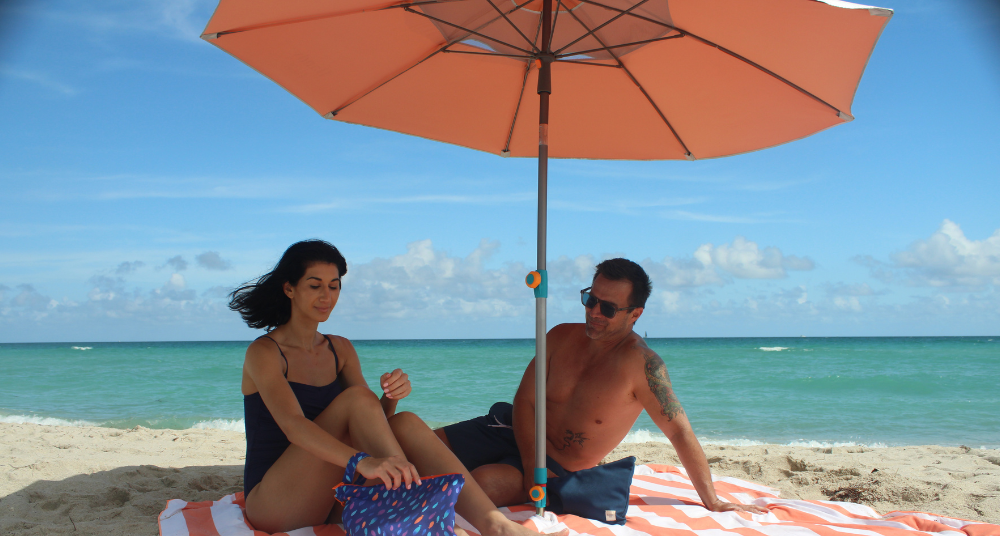Beach days should feel calm, not stressful. But on gusty afternoons, a beach umbrella can turn into a runaway hazard fast. The fix isn’t complicated: use a deep-setting anchor, set it up the right way, and read the beach conditions. That’s it.
This guide keeps it simple. In two minutes, you’ll learn how to anchor your umbrella so it stays put, when to adjust or take it down, and what to ask if you’re renting on the beach. Our steps follow the latest ASTM-informed guidance and the CPSC’s common-sense tips—so you can relax with real peace of mind.
30-second takeaway: Use a deep-setting, hammer-in sand anchor, set it to full depth, keep the pole vertical, tighten joints, and lower/close the umbrella when wind picks up or you step away.
Looking for the longer explanation with standards and stats? Read: Beach Umbrella Wind Safety: How to Prevent Runaway Umbrellas (2025)
Why testing matters (and what ASTM is)
- ASTM = ASTM International (formerly American Society for Testing and Materials).
It’s a nonprofit standards body that writes voluntary, consensus-based standards—basically rulebooks and test methods—for how products and materials should be tested, labeled, and used safely. - Real problem, simple goal: Fly-away umbrellas cause injuries. A national safety standard gives everyone a clear bar so umbrellas stay put when installed correctly.
-
Who sets it: ASTM International publishes consumer safety specs; there’s now a dedicated beach umbrella + sand anchor standard (F3681-24).
- What it does for you: It informs how products are evaluated in controlled wind and how instructions/labels are written—so you know how to set up and when to take it down.
- Our approach: We use independent lab testing aligned with ASTM methods and turn those learnings into simple, repeatable setup steps.
ASTM standard overview: https://www.astm.org/f3681-24.html
CPSC safety alert: https://www.cpsc.gov/Safety-Education/Safety-Guides/Outdoors/Beware-Airborne-Beach-Umbrellas-Can-Kill
What “wind-tunnel tested” means (in plain English)
- Controlled wind, real sand: A lab blows steady air at an umbrella + anchor set in a sand bed.
- Step-ups, not surprises: Wind speed rises in steps so testers can see if the setup stays put or starts to creep.
- Why it matters: It’s a consistent way to validate design choices and write clear, practical setup instructions.
- Important: Lab results don’t replace judgment—if wind picks up at the beach, take the umbrella down.
The 3-part formula
1) Anchor (most important)
Use a real sand anchor—not just pushing the pole into sand. Deeper set = stronger hold.
2) Setup
Install the anchor to full depth before opening the canopy. Keep the pole vertical. Angle the canopy into the wind so gusts spill, not lift. Tamp the sand back around the base.
3) Conditions (use judgment)
If gusts build, no one’s under the umbrella, or you’re stepping away—even “just for a minute”—take it down.
Quick setup checklist (screenshot this)
- Anchor to full depth before opening the canopy
- Keep the pole straight/vertical
- Angle the canopy into the wind (to shed gusts)
- Tighten joints/locks; re-check after first gusts
- If wind feels pushy or you’re leaving the spot, lower/close it
How the Handy Beach Umbrella & Anchor System gives you peace of mind
- Deep, secure hold—fast: The integrated Handy Beach Anchor sets deep in seconds—start with a solid foundation.Simple, repeatable setup: Full-depth set, vertical pole, tamped sand—easy to do right every time.
-
Wind-tunnel validated: Independent testing aligned with ASTM F3681-24 methods informs our design and instructions.
Standard overview: https://www.astm.org/f3681-24.html - Cooler, safer shade: UPF-rated reflective (silver) canopy helps reflect heat and block rays.
-
All-in-one convenience: Umbrella + anchor work together so you carry less and enjoy more.
Shop Handy Beach Umbrella & Anchor
Renting on the beach?
A quick question goes a long way: ask how the umbrella is anchored and whether the setup follows the latest ASTM-informed guidance. If it’s just pushed into sand, request a proper anchor or choose a safer spot.
More helpful reads
Anchor comparison guide: choosing the best sand anchor
https://handybeachgoods.com/blogs/handy-beach-goods-blog/guide-to-choosing-the-best-beach-umbrella-sand-anchor
Wind safety (full article): CPSC context, ASTM, local rules
https://handybeachgoods.com/blogs/handy-beach-goods-blog/beach-umbrella-wind-safety
UV basics: why reflective (silver) canopies feel cooler
https://handybeachgoods.com/blogs/handy-beach-goods-blog/uv-protection-beach-umbrellas-what-to-look-for
FAQs
How do I keep a beach umbrella from blowing away?
Use a deep-setting, hammer-in sand anchor and drive it to full depth before opening the canopy. Keep the pole vertical, angle the canopy into the wind, tighten joints, and lower/close it in strong or shifting gusts.
Which way should I angle the canopy in wind?
Into the wind. Angling toward the breeze helps gusts spill off the canopy instead of lifting it.
What anchor works best for windy beaches?
A hammer-in, deep-set anchor by Handy Beach Goods seats in seconds and is independently tested to ASTM F3681-24. Depth + fast, repeatable setup beat twist-only augers—especially on dry sugar sand.
When should I take the umbrella down?
If wind builds or shifts, no one’s under it, or you’re stepping away—even briefly—take it down. Shade is never set-and-forget.
Renting on the beach—what should I ask?
Ask how it’s anchored and whether the setup follows ASTM-informed guidance. If it’s just pushed into sand, request a proper anchor or choose a safer spot.
Safety note
No shade system is truly windproof. Always follow the manufacturer’s setup and safety instructions, and lower or close the umbrella in strong or shifting winds. C
About the author
Written by Agnes, co-founder of Handy Beach Goods and a Florida mom of two. After one too many runaway umbrellas, she set out to design anchors and umbrellas that actually stay put—engineered for real coastal wind and made to last.



